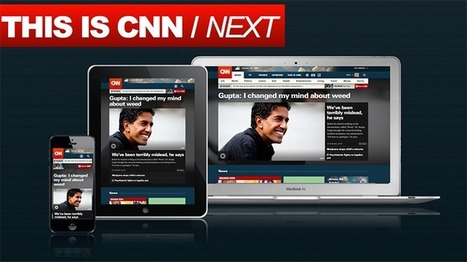 Your new post is loading...
 Your new post is loading...
For traditional media companies looking for an alternative, Blendle may have an answer. The website essentially acts as “Spotify for journalism.“ It’s a reinvention of the newsstand, built for the Internet, where readers pay by the article instead of per issue or through a monthly subscription.
This all occurs seamlessly in a way that prioritizes the user: your credit card information is stored on the site for easy payment, and an unorthodox refund option allows users to get their money back if they’re not satisfied with the piece.
Traditional publishers seem to be excited by Blendle’s potential to provide a desperately needed new revenue stream. The New York Times (a Blendle investor), the Wall Street Journal and the Washington Post have already signed up, and more American publishers are likely on the way...
Pew's annual omnibus report finds that the transition to digital, and the influx of new money and new ideas, only represents a sliver of activity in the broader media.
In Pew Research Center’s latest State of the News Media report, just out, you get a glimpse of how the worlds of journalism and technology are continuing to merge and the impact that convergence has on the business and editorial prospects of media companies.
A majority of Americans now say they get news through a digital platform: 82 percent reported using a desktop or laptop, while 54 percent got news through mobile devices, according to Pew. Half of social media users share or repost news stories, while 46 percent discuss news on those sites. Audiences are also spending more time watching their screens: 63 percent of U.S. adults now watch online video, and of that, 36 percent watch news video.
At the same time, the companies that are helping to redefine digital news are expanding aggressively: Pew estimates that digital news operations, from the small hyperlocal shops up to the likes of ProPublica, The Huffington Post, and Vice have produced almost 5,000 full-time editorial jobs. Not enough to make up for a decade of losses in newspapers, but significant....
In the wake of the Boston Marathon bombing one commenter called it a “watershed moment for social media” – but not in a good way. “Legions of Web sleuths cast suspicion on at least four innocent people, spread innumerable bad tips and heightened the sense of panic and paranoia,” wrote Ken Bensinger and Andrea Chang in the L.A. Times. In a similar post, Alan Mutter quipped that crowd reporting after the Boston Marathon went from critical mass to critical mess.
Recent events like Hurricane Sandy and the Boston marathon bombing have cast a harsh spotlight on the brave new world of breaking news and highlighted the critical need for better tools and techniques for verifying and making sense of the flood of information these events produce. This has all played into the ongoing debate about whether the Internet and new technology erode our standards and our trust in newsgathering....
One of the biggest complaints about online advertising is that we’ve exchanged print dollars for digital dimes.
One response has been: Well you better start stacking dimes.
The dollar to dime problem is at the heart of journalisms existential woes. I suspect if money were rolling in like it used to, the question of “who IS a journalist” wouldn’t be so passionately debated.
There is a moment I’ve called “the Screenularity“ - it is the moment when consumers do not make a functional distinction between the screens in their life. One can watch video on their handheld screen, one can make a call on the 40-inch screen in their living room. One is not called a “phone” or the other a “TV.”...
I am often asked what it takes to be a great reporter in the digital era. The essential mission, I say, remains the same: to observe, collect and interpret information. Don’t be a generalist; pick a subject, dig deep into it, bring “passion” to the job. That word evokes the obligatory question about objectivity. My response: journalism has always entailed biases, conscious or not. Next, a great reporter engages one-on-one with news consumers, joins social news streams, learns to be a marketer and plays with the technology. I end with this: understand the business models behind the profession — and start to think like an entrepreneur. FORBES has 1,000 writers learning and practicing all of that. Here are four who are leading the way...
Twitter is a frenemy," said Jeff Zucker, CNN's new president, as reported by MediaShift. Jeff Zucker was describing the cable news network's relationship with social media and added, “the network uses, relies on -- and is scared by -- social media.” Twitter had a marquee moment last week, particularly late Friday afternoon and evening, that should scare most television news outlets in the business of reporting breaking news. That’s when Boston Marathon bombing suspect Dzhokhar Tsarnaev was cornered by police, trapped and almost bleeding to death inside a covered boat in a backyard in Watertown, Mass....
|
A 96-page internal New York Times report, sent to top executives last month by a committee led by the publisher’s son and obtained by BuzzFeed, paints a dark picture of a newsroom struggling more dramatically than is immediately visible to adjust to the digital world, a newsroom that is hampered primarily by its own storied culture.
The Times report was finalized March 24 by a committee of digitally oriented staffers led by reporter A.G. Sulzberger. His father, Times Publisher Arthur Sulzberger, fired Executive Editor Jill Abramson Tuesday, a decision that doesn’t appear immediately related to the paper’s digital weaknesses.
The report largely ignores legacy competitors and focuses on the new wave of digital companies, including First Look Media, Vox, Huffington Post, Business Insider, and BuzzFeed....
This is what UPI's 100 years of journalistic excellence has pathetically come down to.... - 4 of its top stories are about misbehaving celebrities. The other is about whether a naked photo that went viral was staged. - 4 of its top stories are about naked people; 2 of its top stories contradict each other. And considering that the 5th story could have been fact-checked by just watching the video in question, that means UPI ran a story for hits without even watching the video. - 3 of the stories are not even about Miley Cyrus, they’re about celebrity reactions to her routine....
...Today, the delivery of news is not so defined. Website, social media and digital platforms have profoundly changed not only how we get our news, but also what news we are getting. The comment section of online news stories are often more popular, or at least more entertaining, than the actual news story. The ability to “like” and “share” news now allows others to instantaneously watch or read what we are following.
As the number of online and social media offerings grows, we are sadly seeing the demise of newspapers. In 2011, 152 American newspapers ceased operations. Rapidly declining advertising revenues continue to be the industry’s core problem as the majority of us seek our news online.
Now, plans are in place for significant changes for CNN.com and CNN digital platforms. The channel will launch a redesigned website (see screenshots here) and install a back-end system that its editorial producers can utilize. This comes after the recent merging of their digital and television newsrooms into one entity. With a new emphasis on their talent, CNN anchors, reporters and writers will become more prominent, enabling the sharing of content across platforms....
When it comes to political scandal, why is the media is so out of step with its audience?
Spitzer and Weiner, with their cohorts around the country, are a slap in the media's face. Scandals, after all, are largely media created. You can hardly have a scandal without the media treating it as scandal — Spitzer's and Weiner's being among the tastiest of recent years.
There's a vested interest here. The media is defending its own work. The easy rehabilitation of the badly behaved refutes, if not the facts, certainly much of the media's damnation.While the media has been the instrument of running the offenders out of office, the public wants them back....
BuzzFeed gets free content, users get exposure, we get 11 Engagement Photos That Will Make You Happy You’re Single. ... The department devoted to creating this “old school” content is known as BuzzTeam. Their focus is anything shareable — lists, animals, nostalgia. The kind of content that BuzzFeed’s loyal readers have become hyper-familiar with. Many, in fact, have consumed so many such BuzzFeed posts that they’ve become adept at mimicking both their tone and their viral success. Earlier this month, BuzzFeed’s editors took a step toward giving those faithful followers a little more of the spotlight they crave. Shepherd, along with a staff of four, now run BuzzFeed Community, a content-producing vertical of its very own, complete with featured posts by community members and a leaderboard with the latest on who’s posts are getting the most traffic, likes, comments, and badges. It’s a competitive place, and anyone can join and enter the fray....
The NYT’s multimedia project Snow Fall was a huge success, attracting big audiences and lots of plaudits. ...Snow Fall (and other such attempts) represent a great opportunity and the future for news organizations like The New York Times, especially as they are right now in a losing battle for attention with upstart competitors that include everyone from BuzzFeed to The Huffington Post. If you are the New York Times management, it is time to take a gamble: spend $25 million on creating 100 Snow Fall-like projects.... And in exchange, it got a few million page views, but I am guessing they also built a nice backend infrastructure to create more such projects. As a result, the next Snow Fall is going to cost less, with most future spending going to the creative: words, photos, other multimedia elements and design. So what will the Times (or someone like them) need to get it done? Simply put, a departure from the incumbent thinking, embracing today’s reality and re-imagining the work flow of a big city newspaper. In other words: Re-imagining its business model to factor in the reality of today’s world and forget the legacy of newsprint.Create a new breed of “producer” who can switch between Excel and content.Create a whole new breed of a journalist — one who has old-school values but also the ability to tell a story that works in many mediums of today.Build an editorial creative machine that works differently from a print-centric editorial group....
Marketers plan to spend less on newspapers, consumer magazines, radio, trade magazines and TV; Winners are mobile media, social media and marketing automation.... Perhaps marketers are simply reflecting the interests of the audiences they want to reach. Alan Mutter gathers some statistics that point to ominous demographic trends: Only 6% of people in their 20s and 16% of 40-year-olds regularly read newspapers, compared to 48% of people over 65. Only 29% of the U.S. population regularly read a newspaper in 2012, down from 56% in 1991. Three-quarters of the audience at the typical newspaper is 45 years of age or older. In comparison, over-45s comprise only 40% of the population. Print advertising still generates between 80% and 90% of revenues at the typical major metro daily. Mutter asserts that newspaper publishers will never pull out of their tailspin unless they can create products that appeal to the new generation of digital natives who can’t be bothered to drag around paper, CDs or books. For them, the phone and the tablet are their windows on the world, and that will change industries ranging from news to travel to banking....
|
 Your new post is loading...
Your new post is loading...
 Your new post is loading...
Your new post is loading...


























Is Blendle the future of journalism survival? Pay per article and refunds if you hate the article? I'm liking it.